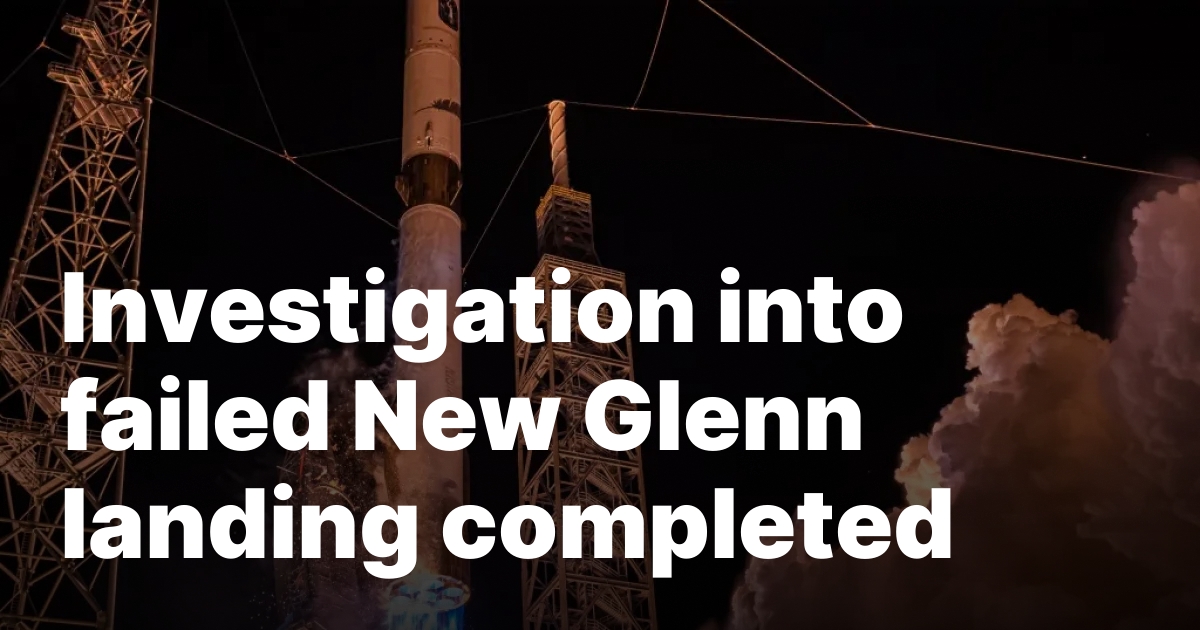Blue Origin’s New Glenn Rocket Set to Return to Flight Following Investigation Outcomes
In a significant development in the commercial spaceflight industry, Blue Origin announced that its New Glenn rocket is poised for another attempt at launch as early as late spring. This announcement follows a comprehensive investigation into a mishap that occurred during the vehicle’s maiden flight, which involved a failed booster landing.
The Federal Aviation Administration (FAA) released a statement on March 31, indicating its acceptance of the investigation results led by Blue Origin. The probe examined the inaugural flight of New Glenn, which took place on January 16. During this mission, while the upper stage of the rocket successfully reached orbit, the first stage did not manage to land as planned on a Blue Origin recovery ship stationed in the Atlantic Ocean.
According to the FAA, the mishap’s immediate cause was identified as the failure of New Glenn’s first stage to restart its engines, which was crucial for executing a reentry burn. This failure resulted in the loss of the stage. Blue Origin has outlined seven corrective actions to address these issues, although specific details of these measures were not disclosed.
With the investigation now complete, Blue Origin has been cleared to proceed with the next flight of their rocket, contingent on the FAA’s confirmation that the corrective actions have been satisfactorily implemented. The FAA confirmed, "The Blue Origin New Glenn vehicle is authorized to return to flight provided all other licensing requirements are met."
In a social media update that coincided with the FAA’s announcement, Blue Origin stated, "Our ambitious attempt to land the booster, dubbed ‘So You’re Telling Me There’s a Chance,’ was unsuccessful due to our three BE-4 engines not re-igniting properly." The company emphasized that the corrective actions focus on enhancing propellant management and engine bleed control, which they are actively addressing.
The upcoming flight, scheduled for late spring, will involve another attempt at landing the booster. However, the company has not yet provided a more precise timeline or disclosed the payload for this mission. A Blue Origin spokesperson communicated that no further details beyond the social media announcement would be shared at this time.
Dave Limp, Blue Origin’s chief executive, reiterated during the Commercial Space Conference on February 12 that the company is aiming for a late spring timeframe for New Glenn’s next launch. He noted that the primary issue leading to the booster loss involved challenges with propellant delivery to the engines, although further details were withheld due to the ongoing investigation at that time.
Expressing optimism, Limp shared on social media, "We’re confident that the propellant and bleed control work we’re doing will increase our chances of landing the booster on our next flight. And like we’ve said all along, we’ll keep trying until we do."
The FAA’s March 31 announcement also addressed a separate investigation concerning SpaceX’s Starship vehicle, which encountered a similar fate during its seventh test flight on the same day as New Glenn’s inaugural launch. The mishap report highlighted that unexpected strong vibrations during the flight led to increased stress and eventual failure of the propulsion system hardware, aligning with SpaceX’s previous assessments.
Despite the ongoing investigation, the FAA authorized SpaceX to proceed with another Starship test flight, having completed a thorough safety review. However, the Starship upper stage was again lost during a similar phase of flight on its eighth test flight, conducted on March 6.
As the investigation into the latest Starship test continues, the FAA has stipulated that SpaceX cannot launch Starship again until they accept the final mishap investigation report or determine a return-to-flight status, alongside meeting all other licensing requirements.
Industry Insights and Reactions
The aerospace community has been closely monitoring these developments, given their implications for the future of commercial space travel. Blue Origin and SpaceX are both pivotal players in this sector, with their advancements and setbacks shaping the trajectory of space exploration and commercial launches.
While Blue Origin’s New Glenn project represents their ambition to offer reliable and reusable launch vehicles, the recent setback underscores the challenges inherent in developing new space technologies. The mishap and the subsequent investigation highlight the complex interplay of engineering, safety, and innovation required to succeed in this high-stakes arena.
For Blue Origin, the corrective actions focusing on propellant management and engine control are critical. Efficient propellant management ensures that the engines can be restarted reliably, a vital aspect for any reusable rocket system. Engine bleed control, which involves regulating the flow of fuel and oxidizer to the engines, is another crucial area that can significantly impact engine performance and reliability.
Similarly, SpaceX’s experience with the Starship vehicle highlights the unpredictable nature of spaceflight. The persistent issues with vibrations affecting the propulsion system illustrate the challenges of scaling up rocket technologies for larger and more powerful vehicles. SpaceX’s iterative approach to testing and development, characterized by frequent launches and rapid prototyping, allows them to learn from each flight and refine their designs.
Conclusion
Both Blue Origin and SpaceX’s endeavors are testaments to the dynamic and rapidly evolving landscape of space exploration. As these companies work through their respective challenges, they contribute invaluable lessons and technological advancements to the industry. The outcomes of their investigations and corrective measures will undoubtedly influence their future missions and the broader field of commercial spaceflight.
As we await the next launches from Blue Origin and SpaceX, the anticipation within the industry and among space enthusiasts continues to build. These missions not only represent milestones for the companies but also for humanity’s ongoing quest to explore beyond our planet.
For more Information, Refer to this article.


































